BLOG, or DIE. Author Bio
Tuesday, 8 June 2010
A real bad guy
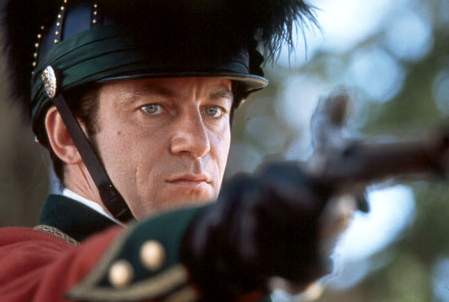
Jason Issacs as Colonel William Tavington of the Green Dragoons.
Beginning today’s post with a confession…I must admit that my list of guilty pleasures includes the sappy and dramatic Mel Gibson film “The Patriot.” Released in 2000, this movie tells the story of a family’s experiences surviving and fighting in the American Revolution in South Carolina. Despite being a period-film it did very well at the box-office and was nominated for three Academy Awards including Best Sound, Best Cinematography, and Best Original Music Score. The main character in the story is a noble man named Benjamin Martin who was loosely based on Francis Marion “The Swamp Fox.” The plot is fairly simple: A renowned veteran of the French and Indian War and widowed father of seven children, vows to avoid fighting the British until his son is killed and his home is burned to the ground. He then proceeds to make life miserable for Lord Cornwallis and his troops.
Despite the obvious Hollywood flair, the history in the film is fairly accurate. Gibson is joined on screen by the late, great Heath Ledger, but the most notable performance comes in that of the villain, Colonel William Tavington, commander of the elite Green Dragoons, as portrayed by the noted British actor Jason Issacs. This guy is pure evil and Issacs is so convincing, you literally hate him by the end of the first scene in which he appears. His character is a sadistic and unrepentant military officer with no conscience or battlefield ethics. In one scene he shoots Benjamin Martin’s young son in cold blood, in another he orders an entire town’s residents to be locked in their own church and burned alive. His line, “The ends justify the means.” It is a memorable performance to say the least.
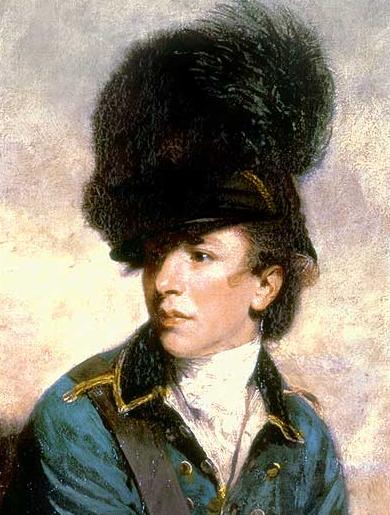
Sir Joshua Reynolds’ 1782 portrait of General Banastre Tarleton.
What most folks may not know is that Colonel William Tavington was based closely on a very real and equally feared trooper named General Sir Banastre Tarleton.
According to the Wikipedia entry on Tarleton: In a publication “THE GREEN DRAGOON: The Lives of Banastre Tarleton and Mary Robinson” by Robert D. Bass he was given the nickname “Bloody Ban” and The Butcher, which has carried over into popular culture as being his nickname of the day. According to his bio, He was hailed by the Loyalists and British as an outstanding leader of light cavalry, and was praised for his tactical prowess and resolve, even against superior numbers. His green uniform was the standard of the British Legion, a provincial unit organized in New York in 1778. Tarleton was later elected as a Member of Parliament for Liverpool and became a prominent Whig politician. Tarleton’s cavalrymen were frequently called “Tarleton’s Raiders.”
Tarleton’s legacy as a ruthless commander followed his actions at the Battle of Waxhaw. They are still debated today. In May of 1780, Tarleton’s forces consisting of 150 mounted light infantry troops overwhelmed a detachment of 350+ Continental infantryman led by Abraham Buford. It is argued that despite their surrendering, Buford’s men were attacked and cut to pieces by Tarleton’s men. Estimates state that 113 Americans were killed, 150 were severely wounded and 203 were captured and abused. The British referred to this battle as the Battle of Waxhaw Creek, while the Continentals called it “The Waxhaw Massacre.”
In retrospect, some accounts have since then supported the notion that Tarleton’s men attacked on their own accord. An American field surgeon named Robert Brownfield wrote that Col. Buford had indeed raised a white flag of surrender, but that Tarleton’s horse was shortly after struck by a musket ball and fell. This gave the impression that the rebels had shot at Tarleton while asking for mercy. Enraged, the British cavalrymen charged. According to Brownfield, the loyalists attacked, carrying out “indiscriminate carnage never surpassed by the most ruthless atrocities of the most barbarous savages.” In Tarleton’s own account, he stated that his men, thinking him dead, engaged in “a vindictive asperity not easily restrained.”
Our friend Eric Wittenberg has an excellent feature on this affair in the current May/June issue of Patriots of the American Revolution.

Friday, 4 June 2010
All about the Benjamins
UPDATE 5/6: Stay tuned for a feature-length version of this post in an upcoming issue of Patriots of the American Revolution magazine.
Even if you’re not a student of the Founding Fathers, chances are they are always with you. From George Washington, to Thomas Jefferson and Alexander Hamilton, their faces are more than likely tucked away in your wallet, printed on our nation’s currency. Most American monies feature former presidents, but two dollar bills, the $10 and $100, depict non-presidents who made an equal impact the nation’s history.
The one-hundred-dollar bill features the country’s most treasured statesman Benjamin Franklin. Perhaps no other American’s portrait is more deserving of this honor as the immense list of contributions that he left us with would fill a small library (another one of his ideas). Franklin’s was the first bill to feature a non-commander-and-chief and it is commonly referred to in slang as a “Benjamin.” According to the Bureau of Engraving and Printing at the U.S. Department of the Treasury, the average life of a $100 bill in circulation is 89 months before it is replaced due to wear. Approximately 7% of all notes produced today are $100 bills.
The irony is that Ben Franklin himself was one of the original proponents and printers of paper currency and in 1729 he wrote, “There is a certain proportionate Quantity of Money requisite to carry on the Trade of a Country freely and currently; More than which would be of no Advantage in Trade, and Less, if much less, exceedingly detrimental to it.” It is also peculiar that his likeness adorns the highest denomination of commonly circulated bills when compared to the lesser-valued ones featuring his presidential counterparts.
The very first $100 denomination, issued in 1862, did not feature any portrait in favor of a bald eagle. In 1869 a new version was issued with Abraham Lincoln’s likeness. In 1914 the first $100 Federal Reserve Note was issued with a portrait of Benjamin Franklin of which we are familiar with today. Under the series of new printings in 1928, all U.S. currency was changed to its current size and began to carry a standardized design. From then on, all variations of the $100 bill would carry the same portrait of Benjamin Franklin. Since Series 1928, the $100 note has also featured an engraving of Independence Hall in Philadelphia on the reverse-side. The former State House of Pennsylvania, Independence Hall is often called the birthplace of our Nation and has strong ties to Franklin’s legacy.
In the 1990’s, new-age anti-counterfeiting measures were implemented with microscopic printing added around Franklin’s portrait and a metallic security strip on the left side of the bill. A completely redesigned, state-of-the-art Series 2009 $100 bill was unveiled on April 21, 2010 and will be issued to the public on February 10, 2011. Like the country that honors him, Franklin’s bill has gone through several evolutions and he has also been featured on special limited edition gold coins and bank notes.
From top, down: 1914 Series, 1966 Series, 2003 Series, 2010 Series.

Wednesday, 2 June 2010
Signs of the times
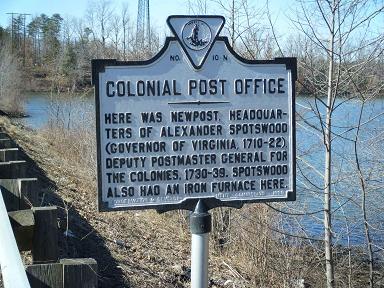
I live in Fredericksburg, Virginia, southern Spotsylvania County to be exact. There are dozens of roadside Historical Markers in the area with many more reaching out in all directions. The vast majority of these signs are related to the Civil War, but if you look carefully, you can find markers acknowledging the Colonial-era. Unfortunately, they tend to be quite obscure and in places that you would never think of going. I find this rather disappointing and have always felt that the region neglects far too much of its earliest history. These roadside markers provide a great opportunity to remind visitors that Fredericksburg had a life and legacy before 1862.
One marker that I pass every morning is the E 46 Colonial Fort sign. Erected in 2004 by Department of Historic Resources, it is located on Tidewater Trail (Virginia Route 2) 1.1 miles east of Lansdowne Road, on the right when traveling east. (It is also a few hundred yards up the road from the site of the Slaughter Pen.) The marker reads:
The Virginia General Assembly authorized the construction of a fort built nearby along the Rappahannock River in 1676. It served as a defensive fortification for settlers of European descent on the frontier when periodic conflicts occurred between Virginia Indians and settlers. Maj. Lawrence Smith commanded the fort. Smith had patented 6,300 acres of property with Robert Taliaferro in the region in 1666. Smith later obtained more land nearby. The fort was abandoned about 1682, when the General Assembly ordered the dismantling of many of these structures.
A short distance away is a much older marker titled N-10 Colonial Post Office. Erected in 1928 by the Conservation & Development Commission, this sign is also located on Tidewater Trail (Virginia Route 2) 0.6 miles east of Jim Morris Road (County Route 609), on the left when traveling east. It states:
Here was Newpost, headquarters of Alexander Spotswood (Governor of Virginia, 1710-22), Deputy Postmaster General for the colonies, 1730-39. Spotswood also had an iron furnace here.
Ironically, this region is still quite rural when compared to the surrounding county. The post office sign stands near Ruffin's Pond and the fort marker is adjacent to a cornfield. I plan to do some additional research into these two sites and will share my findings. I also invite anyone who may be familiar with these markers, or the history behind them, to comment below. Perhaps we can collectively add to their story.
(Image Source: HMdb.org)

Sunday, 30 May 2010
July/August PAR
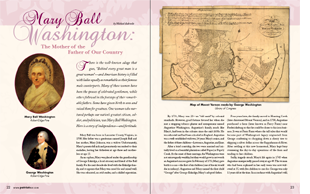 The good folks at Patriots of the American Revolution were kind enough to send me a sneak peek at my Mary Ball Washington feature that is running in the upcoming July/August issue. They had to cut some to fit, but it still turned out pretty good. I will post the entire copy and a PDF of the printed article once it hits the store shelves. I absolutely love writing for this magazine as they seem to bring out my best work. Be sure to grab a copy.
The good folks at Patriots of the American Revolution were kind enough to send me a sneak peek at my Mary Ball Washington feature that is running in the upcoming July/August issue. They had to cut some to fit, but it still turned out pretty good. I will post the entire copy and a PDF of the printed article once it hits the store shelves. I absolutely love writing for this magazine as they seem to bring out my best work. Be sure to grab a copy.
Wednesday, 26 May 2010
Preparing to prepare
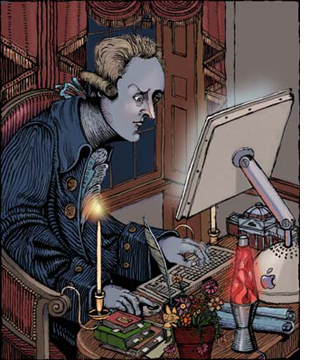 Yesterday I received an email from Ms. Anna Berkes, who is the research librarian at the Jefferson Library. According to her bio on the library’s blog she “Answers reference questions, buys books, and trawls through professional literature.” She has already provided a tremendous service by identifying reference materials for my new book project Faith and Freedom in Fredericksburg: Thomas Jefferson and the Virginia Statute of Religious Freedom (Copyright 2010).
Yesterday I received an email from Ms. Anna Berkes, who is the research librarian at the Jefferson Library. According to her bio on the library’s blog she “Answers reference questions, buys books, and trawls through professional literature.” She has already provided a tremendous service by identifying reference materials for my new book project Faith and Freedom in Fredericksburg: Thomas Jefferson and the Virginia Statute of Religious Freedom (Copyright 2010).
A few weeks ago I contacted the good folks at the TJ Foundation to inquire about obtaining primary sources. Ms. Berkes graciously offered to assist and provided me with a list of essentials. Thanks to her invitation, I will be traveling to Charlottesville over the summer to browse their archives and study documents from their collection. They also have the largest catalog of secondary sources on Thomas Jefferson in the country. As Monticello is my “Disneyland” you can only imagine what a thrill this is.
By Anna’s recommendation we were able to identify a number of recordings on Jefferson’s time here in Fredericksburg (specifically in 1777) including Jefferson's Memorandum Books: Accounts, with Legal Records and Miscellany, 1767-1826, as well as misc. selections from the Papers of Thomas Jefferson. The Thomas Jefferson Encyclopedia that is available online via the Monticello website is also a great source of information.
Locally, I am blessed to have the assistance of Barbara Willis, Jeffrey Edmunds and Nancy Moore at the Central Rappahannock Regional Library and fellow historians Marian McCabe and "Skip" Nolan. They have already provided me with copies of newspapers and articles from publications like The Freedom Record and the Thomas Jefferson Institute Quarterly and are obtaining more references for me from the University of Mary Washington and the College of William and Mary.
Every January there is a multi-denominational observance here in Fredericksburg recognizing the Statute. It is held on Washington Ave where a modest monument to Jefferson’s act stands. Apparently the sponsor of this celebration is a Masonic organization called the Sojourners. I am hoping to get in touch with them as well.
With this many people guiding me, I can’t possibly go wrong.
My greatest pleasure as a historian has always been found in the research process. Writing and editing is simply the conclusion to the journey. I have even lectured on historical research and writing to groups like the Kappa Delta Gamma Sorority (Beta Eta Chapter) and the Pittsburgh Writer’s Group (Read Transcript).
I admit that research can be boring, and painful, and frustrating at times, but there is nothing more gratifying than digging through a dusty archive and uncovering something that hasn’t seen the light of day in years. To quote Carl Sagan “Somewhere, something incredible is waiting to be known.”
By focusing on this aspect, the scholarly phase of historical study, it has enabled me to grow both personally and professionally. In fact, if you read my first few books, versus my last two, you will note a significant difference in what I write about - and how I write it. Frankly, I have matured.
I can hardly wait to get started and to think that I will be in the presence of papers that were penned by Jefferson’s own hand (under the supervision of staff of course) will make this process that much more memorable. I have extensive experience examining relics and historical documents, but to see Jefferson’s personal correspondence in person would be something very special.
I’ve outlined a general framework for the manuscript and casually time-lined a schedule that would have me ready for submission to the publisher sometime in mid-late 2012. It may take longer. As I stated in my announcement, this book will be the most challenging, ambitious, and scholarly work of mine to date.
I am in no hurry as this will be my 7th, and perhaps final title. With the exception of penning the occasional article for Patriots of the American Revolution or The Free Lance-Star (…and blog posts of course), my sole writing focus will be on this project. Stay tuned as I hope to share plenty of insights and updates along the way.
PS. Read the formal announcement on this upcoming title.
ABOVE: Artwork by Robert Meganck titled Thomas Jefferson’s Favorite Web Sites.

Newer | Latest | Older









 The good folks at
The good folks at  Yesterday I received an email from Ms. Anna Berkes, who is the research librarian at
Yesterday I received an email from Ms. Anna Berkes, who is the research librarian at